The survival of our democracy—and the survival of a habitable environment and climate—depends on having free and fair elections. This post includes some tips and recommendations of specific ways to help preserve the integrity and security of the election: to make sure that your vote and other people’s votes are counted. (Scroll down to see all of our tips, especially item #4 re. mail-in voting vs. voting in person.)
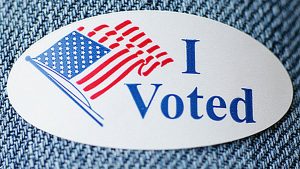 To get started, I hereby offer up the following resources and tools for getting clear, accurate, official information on the voting options and rules in your state/county (beware of disinformation that’s being spread, particularly on social media, and be aware that each state and county has somewhat different voting rules and options). Further down, I have also listed groups that are involved in helping to counter voter suppression (and disinformation and intimidation) tactics and protect the election (from election fraud, tampering, cyber hacking, manipulation, foreign “interference,” or errors; individual voter fraud is almost non-existent and is readily detected, so it is not a major threat).
To get started, I hereby offer up the following resources and tools for getting clear, accurate, official information on the voting options and rules in your state/county (beware of disinformation that’s being spread, particularly on social media, and be aware that each state and county has somewhat different voting rules and options). Further down, I have also listed groups that are involved in helping to counter voter suppression (and disinformation and intimidation) tactics and protect the election (from election fraud, tampering, cyber hacking, manipulation, foreign “interference,” or errors; individual voter fraud is almost non-existent and is readily detected, so it is not a major threat).
Please review, use, and share some of these resources and tools:
State/County Voting Requirements and Information directory (U.S. Vote Foundation)
State by State Voting Information Links (The Green Spotlight)
How to Prevent Your Mail Ballot from Being Rejected (Washington Post)
State Laws on Early Voting (National Conference of State Legislatures)
[Note: 41 states have some form of Early Voting in place. Only 9 states—Alabama, Connecticut, Kentucky, Mississippi, Missouri, New Hampshire, Pennsylvania, Rhode Island, South Carolina—do not offer pre-Election Day, in-person Early voting options.]
Tips to Mitigate Threats to Our Votes and Voter Registrations Before November (Jennifer Cohn, Protect Our Votes)
Four Ways to Safely Cast Your Ballot Without USPS (Democracy Docket)
Orgs/websites for voting information:
- Election Protection (hotline: 866-OUR-V
 OTE, 866-687-8683)
OTE, 866-687-8683) - VOTE411
- Vote.org
- When We All Vote
- Rock the Vote
- League of Women Voters of the U.S.
- VoteRiders
- U.S. Vote Foundation
- Vote Save America
and/or contact your county’s Elections office/department/board/registrar (or your Secretary of State’s elections division) for official, local, up-to-date voting and ballot information.
Orgs/websites re. election protection/integrity/security (including legal action) efforts and safeguards (please click on/follow/share a few, and pick one or two to support/volunteer/join!):
- Protect the Vote (Election Protection)
- WorkElections / Power the Polls / Poll Hero
- Scrutineers
- Democracy Docket
- Protect Our Votes
- Protect Our Election
- Secure Our Vote
- Safe Voting Now
- Voter Protection Corps
- Fair Fight
- League of Women Voters
- National Election Defense Coalition
- Audit USA
- Let America Vote
- Lawyers’ Committee for Civil Rights Under Law
- We the Action (volunteer opportunities for legal professionals)
- ACLU
- Common Cause
- NAACP Legal Defense Fund
- Verified Voting
- More Than a Vote
- Unhack the Vote
Also follow and share our:
list of Voting / Elections accounts on Twitter and our Twitter posts
TIPS & RECOMMENDATIONS:
- Register early (don’t put it off until your state’s deadline), and re-check your registration periodically, including just over than a month before each election to make sure your name hasn’t been purged and to give you enough time to fix any problems. Make sure your registration has your current address and all of the other information is also correct and has not been altered (name, party preference, etc.). Save a screen shot of your registration and bring that or your registration confirmation card/postcard with you as proof (just in case they say you’re not listed on the voting rolls), if you’re voting in-person.If you move more than a month before the election, re-register to vote right away with your new address. If you have to move within the month before the election, find out if your state allows last-minute or Same-Day Registration during Early Voting or on Election Day; or if you’re moving near-by, ask your County elections office if you are still allowed to vote at the poll location for your old address or what your other options are.
- Make sure you have the required ID (if any is required in your state). Go to VoteRiders.org or go to your Secretary of State’s elections website or your County’s elections/voter registrar site to find out whether/what ID is required to vote. If you need help obtaining or paying for the correct ID before the election, contact VoteRiders or Spread the Vote for assistance ASAP.
- Ask your County elections office/Registrar of Voters whether your County provides Hand-Marked Paper Ballots on Election Day as well as during Early Voting (preferably as the default option, instead of touchscreen/computer voting machines or ballot-marking devices, but at least as an option that you can request instead of the machines), as well as paper pollbooks (lists of voters) as a backup in case their electronic pollbooks malfunction/fail (e.g., Internet connection or power goes out) or are hacked into and tampered with. Ask/demand that your County and State provide: Hand Marked Paper Ballots, paper pollbooks (at least as backup), and no modem/Internet (i.e. hackable) connections for voting machines or ballot scanners; also tell them they must save all ballots and digital ballot images to allow for audits or recounts. Ask them if they will have plenty of local polling places open throughout your County/State so people won’t have to travel far from their neighborhood to vote. Not everyone has a car. (Providing large, centralized voting “centers” is not a good replacement for having many, neighborhood-based polling places. Also, county-wide voting centers will not have paper pollbooks on hand, which can cause serious problems if the e-pollbooks fail.) For more info on these issues, follow @jennycohn1 on Twitter or see ProtectOurVotes.com.
- IF your County provides Hand-Marked Paper Ballots (as regular ballots, not just “provisional,” and they are also provided during Early Voting): I’d generally recommend voting in person (preferably during the Early Voting period to avoid lines and any unexpected issues on Election Day), particularly IF you are young and healthy and you feel confident that your daily schedule will allow you to go vote in person. (Also see #8, 9, and 10 below for more on voting in person.) On the other hand…
IF your County/precinct (only) uses computerized voting machines (e.g. hackable BMDs or DREs), or IF you are elderly or at high risk if you get COVID, or IF you anticipate extremely long lines in your precinct or not having the time to go vote in person for any reason (work, childcare, etc.): it would be better to request a mail-in/absentee ballot if your state allows that [no-excuse absentee voting is currently allowed in two-thirds of the states]. Please follow these steps:
1) Apply for your absentee ballot as soon as you are allowed to (don’t wait until the deadline); find info on how to do so on your Secretary of State’s elections site;
2) When you receive the actual ballot, be sure to read and follow the instructions on it very carefully to make sure you fill it out correctly; sign it where requested (which might be on the return envelope) with your typical signature (the same way you signed when registering to vote or on your driver’s license, for potential “signature matching” issues in some states) so they won’t have any cause to reject it (the GOP will be looking for any excuse to challenge/reject mail-in ballots); unfortunately, rejections of mail-in ballots are frighteningly common, especially for inexperienced voters (please contact your County if you have any questions about their instructions, which are sometimes confusing). Note: If you make a mistake on your ballot, contact your county elections office to find out how/where you can bring your “spoiled” ballot in to have it voided and get a new one (or bring the spoiled ballot to your polling place and have them replace it with a clean ballot).
3) Return your completed ballot as early as possible, ideally dropping it off directly at your County’s elections office or another designated ballot drop-off location/box within your County (since USPS mail service could be significantly delayed and it might not get post-marked or delivered in time). If you mail it, mail it at least two weeks before the election and with as much postage on the envelope as is required. [Note: Some states will not accept ballots that are mailed via non-USPS services such as UPS or FedEx.]
4) Look up whether your state/county offers a way to track your ballot and confirm that it has been received and accepted/counted. Track its status if you can. If you find out or are notified that it has been rejected, please go in to “cure” (fix) your ballot if you are allowed to (some areas allow this). Be aware that most places will not start counting any mail-in ballots until Election Day, and some ballots will not be received or counted until after Election Day.
If you don’t receive your mail-in ballot at least two weeks before the election, report that to your County’s elections office (and Secretary of State), and if it doesn’t arrive in time, go vote in person instead, ideally during Early Voting. If it arrives within the last 10-14 days before the election, do not send the completed ballot back by mail, due to postal delays; drop it off at a designated location instead. - Sign up to be a paid poll worker or “election judge” (for Early Voting and/or for Election Day), as there is a shortage of poll workers in many areas due to COVID (in the past many poll workers have been seniors, but they have good reason to sit this one out due to COVID risks). If there aren’t enough poll workers, counties will close poll locations. See WorkElections.com, Power the Polls, or Poll Hero, or contact your County’s elections office directly to find out how to apply. Be sure to wear a face mask and a face shield when working at the polls.
Or sign up to be a poll monitor/observer/watcher, to help prevent and report any voter suppression or intimidation, correct or report poll workers who may be providing false information, or other problems at the polls; or to observe the counting of absentee ballots. The Republican Party and the DT campaign plan to deploy an “Army” of “poll watchers” (and intimidators, though that is not legal) and they will be looking for any excuse to challenge and reject ballots, so we need to have plenty of poll monitors and count monitors of our own. Contact your state or local Democratic Party, the Biden campaign, or a local candidate/campaign to sign up to be a poll observer. #WatchTheVote - Alternatively, volunteer with Election Protection / Common Cause’s Protect The Vote program. People with legal experience can contact We the Action for call center and/or field program opportunities.
Or “consider volunteering with ProtectOurVotes.com to photograph precinct totals (as shown on precinct poll tapes posted outside many polling places when the polls close) and compare them to the county-reported totals for those precincts. If the two don’t match, this suggests that a potentially serious problem occurred with the tabulation and may support an election challenge.” #PhotoFinish
You could also volunteer with the Scrutineers. To be involved in additional vote protection efforts on election night and beyond (e.g. taking periodic screenshots of election tally results from state or county websites as votes are counted), see item #21 here, and follow @jennycohn1 on Twitter for other suggestions. - Volunteer for or donate to voter outreach/education/registration, and Get Out the Vote (GOTV) efforts (such as texting voters from your computer), through your state or local Democratic Party, a battleground state’s Dem. Party (e.g., PA, AZ, NC, WI, FL, GA, IA, KS, MI, OH, MT, TX, NV, MN, ME, VA, NH, CO; SC, KY, AL, MS), a specific campaign, or a group such as: Mobilize.US, MoveOn, Swing Left, NextGen America, Indivisible, Democrats Abroad, LastElection.org, Sierra Club, Progressive Turnout Project, When We All Vote, Fair Fight, March for Our Lives, Voto Latino, NALEO, Rock the Vote, Black Voters Matter, More than a Vote, Overseas Vote, Nonprofit Vote, DSCC, DLCC, DCCC, NDRC, or All on the Line, among many others. Also, remind all of your friends to vote!
- If voting in person, bring your completed sample ballot with you (which should be sent to you in the mail, or you can download one online) to work off of when filling out your real ballot. Also bring a mask, some water/snacks (maybe some to share too), and perhaps a portable chair/stool if there could be long lines. Offer to drive someone to the polls with you (a senior, young person, neighbor, or someone else who might not have a car). Request a paper ballot that you can mark with a pen. And Jenny Cohn says, “If you must use a touchscreen, compare the human readable text on the paper printout (if any) to your completed sample ballot to ensure the machine didn’t drop or flip your votes. Very few voters will notice such dropping or flipping — especially for down-ballot races — without doing this comparison.” Make sure no races, candidates, or other items are missing.
- If you encounter any problems or irregularities (or questions) prior to or during voting, contact the Election Protection hotline at 866-OUR-VOTE (866-687-8683 — save that number in your phone and share it with others; it’s 1-888-VE-Y-VOTA for help in Spanish). If problems are not immediately or adequately resolved, you should also report the issues to your County Elections office, your Secretary of State’s elections division, your state Democratic Party, the DNC, local or national media, on social media; and/or to legal groups such as Democracy Docket, the ACLU, and you can also send/post a note to @jennycohn1 on Twitter. Do not give up on voting without first at least contacting Election Protection for assistance, and do not vote a provisional ballot unless you confirm with Election Protection that that is the only way you will be able to vote. If there are long lines, please stay in line. Anyone who is in line at the time that polls “close” must be allowed to vote.
- Keep your ballot receipt/stub (if provided), and look up whether your state/county offers a way to track your ballot and confirm that it has been received and accepted/counted. Track its status if you can. (Some states allow you track your ballots through BallotTrax.) And if it isn’t accepted/counted, report that (see the list of groups in the previous item). In highly populated cities, counties, and states, it could take several weeks for all votes (particularly mail-in and overseas/military ballots, some of which won’t arrive until after Election Day) to be counted. Do not expect final or certified election results immediately after the election. Patience is a virtue. Accuracy is more important than instant gratification. (It is wildly irresponsible for any news media to “call” races prematurely, before almost all votes have actually been counted, including mail-in ballots. Please remind media and others about this on social media.) If the reported results differ significantly from recent polls and exit polls, support recount and audit efforts. We must insist on election transparency, security, integrity, and verifiability, especially at a time when Russian operatives are again actively working to manipulate our election like they did last time.
- Avoid sending anything non-crucial (or ordering anything to be shipped) through the US Postal Service (except your mail-in ballot, if you can’t drop it off instead) for the three to four weeks preceding the election, up through the day after the election (from at least Oct. 13 – Nov. 4)—to try to enable the USPS to process all of the ballot mail.
For additional info and tips, see our previous voting posts:
- Get-Out-The-Vote (voter outreach) and Election Security Opportunities
- State by State Voting Information
- Voting and Election Tips and Resources for an even more comprehensive list of links and voting rights/advocacy groups
Also follow and share our:
list of Voting / Elections accounts on Twitter and our Twitter posts
I will be adding some more information and links to this post in the coming days and weeks. So please check back again! And please use and share some of this info with friends. We need all hands on deck to protect and save our democracy.
Vote like your life depends on it and everyone’s future depends on it. Vote for democracy, basic decency, health, sanity, justice, facts and rationality, equality, stability, security, fairness, ethics, and a livable environment.
In solidarity. Thank you.
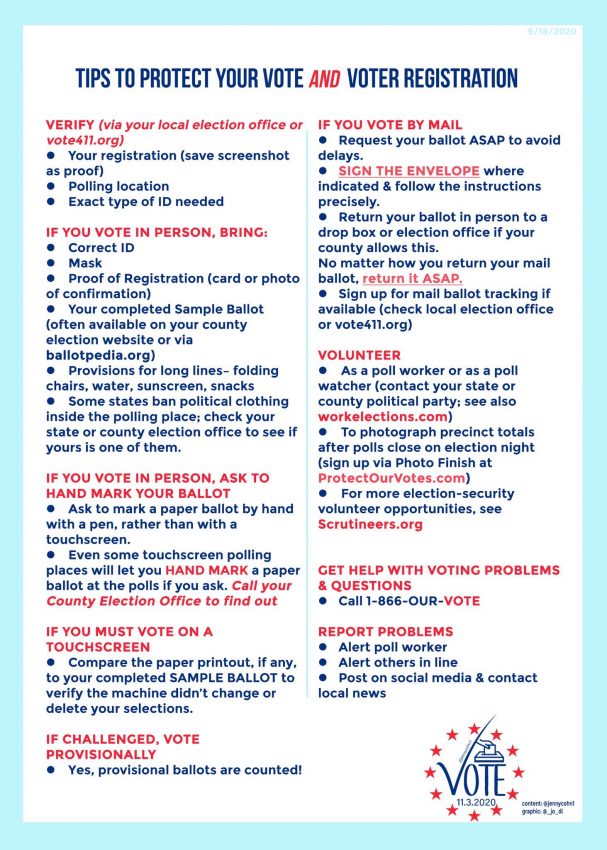
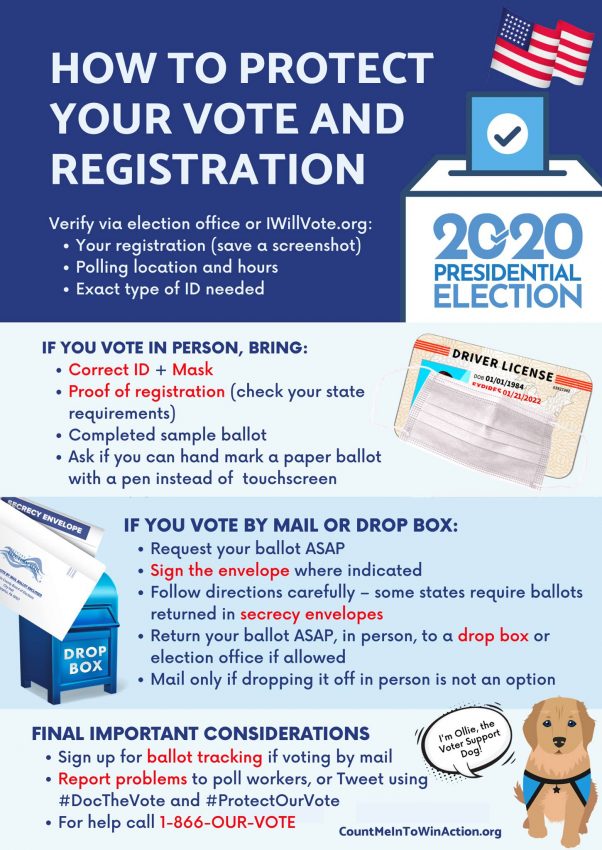




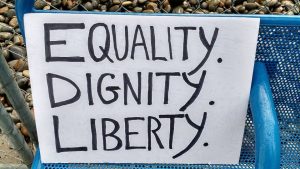 I recommend giving some real thought to your own values and priorities (and desired legacy), and sharing your own mini-manifesto or values/mission statement with others.
I recommend giving some real thought to your own values and priorities (and desired legacy), and sharing your own mini-manifesto or values/mission statement with others.


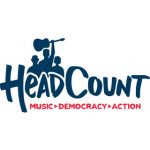
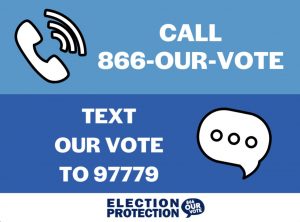
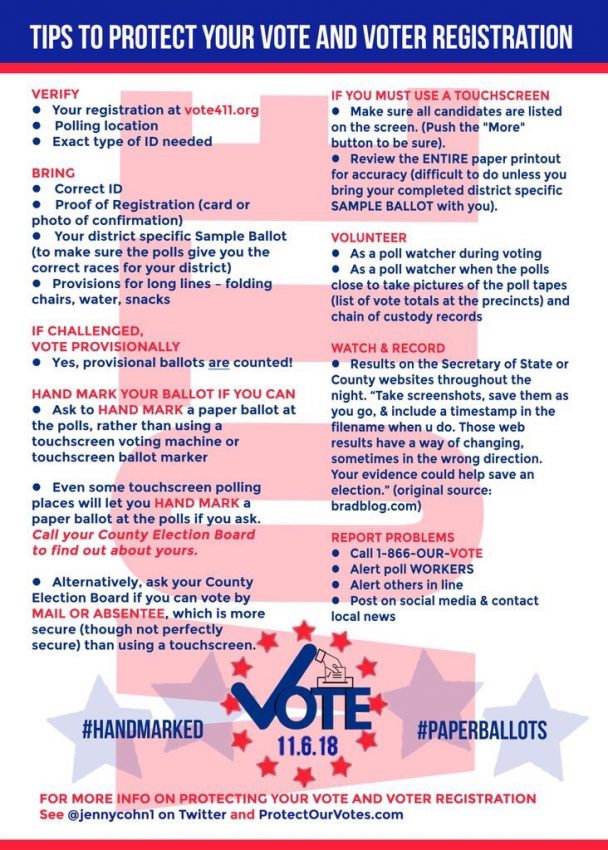
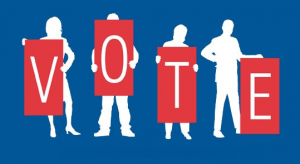

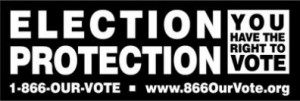 If you experience or witness any voting problems or irregularities, report them to the Election Protection hotline (1-866-OUR-VOTE, or 1-888-VE-Y-VOTA) and to your County elections office and your Secretary of State; you could also report the problems to the DNC, your state’s party, campaign headquarters, and/or to local media. If a poll worker tells you that your voter registration isn’t active or is incorrect in some way, please contact the 866-OUR-VOTE (866-687-8683) hotline before you give up and leave. Some states are wrongly purging some voters from the voter rolls, or your registration could have been hacked. (Notify Verified Voting if you have reason to believe your registration was hacked/altered.)
If you experience or witness any voting problems or irregularities, report them to the Election Protection hotline (1-866-OUR-VOTE, or 1-888-VE-Y-VOTA) and to your County elections office and your Secretary of State; you could also report the problems to the DNC, your state’s party, campaign headquarters, and/or to local media. If a poll worker tells you that your voter registration isn’t active or is incorrect in some way, please contact the 866-OUR-VOTE (866-687-8683) hotline before you give up and leave. Some states are wrongly purging some voters from the voter rolls, or your registration could have been hacked. (Notify Verified Voting if you have reason to believe your registration was hacked/altered.)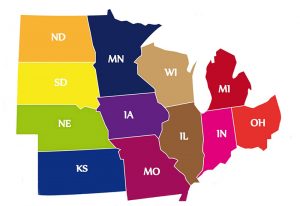


 MICHIGAN
MICHIGAN